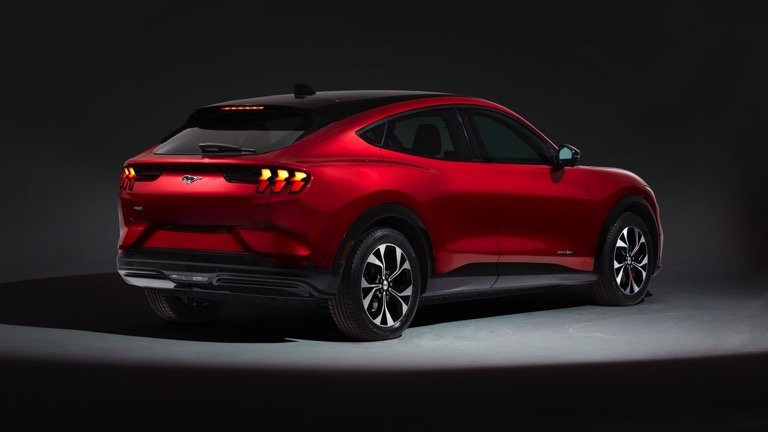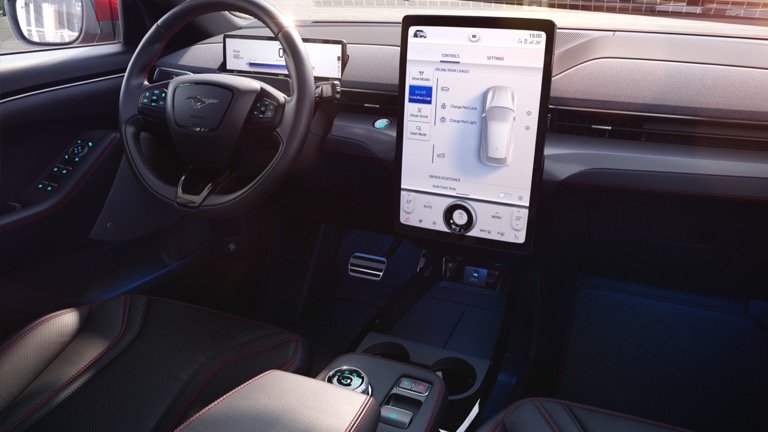Price
Available to Order 01/10/2023
Real Range Estimation between 305 - 615 km
| City - Cold Weather * | 430 km |
| Highway - Cold Weather * | 305 km |
| Combined - Cold Weather * | 480 km |
| City - Mild Weather * | 615 km |
| Highway - Mild Weather * | 385 km |
| Combined - Mild Weather * | 480 km |
Performance
| Acceleration 0 - 100 km/h | 3.7 sec |
| Top Speed | 200 km/h |
| Electric Range * | 425 km |
| Total Power | 358 kW (487 PS) |
| Total Torque | 860 Nm |
| Drive | AWD |
Battery
| Nominal Capacity * | 98.7 kWh |
| Battery Type | Lithium-ion |
| Number of Cells | 376 |
| Architecture | 400 V |
| Useable Capacity | 91.0 kWh |
| Cathode Material | No Data |
| Pack Configuration | 94s4p |
| Nominal Voltage | No Data V |
Charging
Home / Destination
| Charge Port | Type 2 CCS |
| Port Location | Left Side - Front |
| Charge Power | 11 kW AC |
| Charge Time (0->425 km) | 9h45m |
| Charge Speed | 44 km/h |
Fast Charging
| Fastcharge Port | CCS |
| FC Port Location | Left Side - Front |
| Fastcharge Power (max) | 150 kW DC |
| Fastcharge Time (43->340 km) | 47 min |
| Fastcharge Speed | 380 km/h |
Plug & Charge
| Plug & Charge Supported | Yes |
| Supported Protocol | ISO 15188-2 |
Bidirectional Charging (V2X / BPT)
Vehicle-to-Load (V2L)
| V2L Supported | No |
| Max. Output Power | No Data kW AC |
| Exterior Outlet(s) | No Data 1 x Type 2 (Adapter) |
| Interior Outlet(s) | No Data |
Vehicle-to-Home (V2H)
| V2H via AC Supported | No Data |
| Max. Output Power | No Data |
| V2H via DC Supported | No Data |
| Max. Output Power |
Vehicle-to-Grid (V2G)
| V2G via AC Supported | No |
| Max. Output Power |
| V2G via DC Supported | No |
| Max. Output Power |
Energy Consumption
EVDB Real Range
| Range * | 425 km |
| Vehicle Consumption * | 214 Wh/km |
| CO2 Emissions | g/km |
| Vehicle Fuel Equivalent * | 2.4 l/100km |
WLTP Ratings (TEL)
| Range | 490 km |
| Rated Consumption | 212 Wh/km |
| Vehicle Consumption | 186 Wh/km |
| CO2 Emissions | g/km |
| Rated Fuel Equivalent | 2.4 l/100km |
| Vehicle Fuel Equivalent | 2.1 l/100km |
WLTP Ratings (TEH)
| Range | No Data km |
| Rated Consumption | No Data Wh/km |
| Vehicle Consumption | No Data Wh/km |
| CO2 Emissions | No Data g/km |
| Rated Fuel Equivalent | No Data l/100km |
| Vehicle Fuel Equivalent | No Data l/100km |
Real Energy Consumption Estimation between 148 - 298 Wh/km
| City - Cold Weather * | 212 Wh/km |
| Highway - Cold Weather * | 298 Wh/km |
| Combined - Cold Weather * | 249 Wh/km |
| City - Mild Weather * | 148 Wh/km |
| Highway - Mild Weather * | 236 Wh/km |
| Combined - Mild Weather * | 190 Wh/km |
Safety (Euro NCAP)
| Safety Rating | |
| Adult Occupant | 92% |
| Child Occupant | 86% |
| Rating Year | 2021 |
| Vulnerable Road Users | 69% |
| Safety Assist | 86% |
Dimensions and Weight
| Length | 4743 mm |
| Width | 1881 mm |
| Width with mirrors | 2097 mm |
| Height | 1613 mm |
| Wheelbase | 2984 mm |
| Weight Unladen (EU) | 2350 kg |
| Gross Vehicle Weight (GVWR) | No Data |
| Max. Payload | No Data |
| Cargo Volume | 322 L |
| Cargo Volume Max | 1420 L |
| Cargo Volume Frunk | 100 L |
| Roof Load | No Data |
| Tow Hitch Possible | Yes |
| Towing Weight Unbraked | 750 kg |
| Towing Weight Braked | 750 kg |
| Vertical Load Max | 30 kg |
Miscellaneous
| Seats | 5 people |
| Isofix | Yes, 2 seats |
| Turning Circle | 11.6 m |
| Platform | No Data |
| EV Dedicated Platform | No Data |
| Car Body | SUV |
| Segment | JD - Large |
| Roof Rails | No |
| Heat pump (HP) | No |
| HP Standard Equipment |
Home and Destination Charging (0 -> 100%)
It's feasible to charge through a standard wall outlet or a dedicated charging station. Public charging exclusively utilizes charging stations. The speed at which the electric vehicle (EV) charges is determined by the charging station (Electric Vehicle Supply Equipment, EVSE) and the EV's maximum charging capability. The table below outlines all available charging methods for the Ford Mustang Mach-E GT, detailing the speed of charging the battery from empty to full for each method.
Europe
The approach to charging an EV in Europe varies from one country to another. Some countries in Europe predominantly rely on 1-phase electrical connections to the grid, whereas others mainly utilize 3-phase connections. The table below presents all the potential charging methods for the Ford Mustang Mach-E GT, noting that the availability of certain charging modes may be limited in specific countries.
| Type 2 (Mennekes – IEC 62196) |
|---|
 |
| Charging Point | Max. Power | Power | Time | Rate |
|---|---|---|---|---|
| Wall Plug (2.3 kW) | 230V / 1x10A | 2.3 kW | 46h45m | 9 km/h |
| 1-phase 16A (3.7 kW) | 230V / 1x16A | 3.7 kW | 29 hours | 15 km/h |
| 1-phase 32A (7.4 kW) | 230V / 1x32A | 7.4 kW | 14h30m | 29 km/h |
| 3-phase 16A (11 kW) | 400V / 3x16A | 11 kW | 9h45m | 44 km/h |
| 3-phase 32A (22 kW) | 400V / 3x16A | 11 kW † | 9h45m | 44 km/h |
† = Limited by on-board charger, vehicle cannot charge faster.
Fast Charging (10 -> 80%)
Rapid charging facilitates extended trips by maximizing the amount of range added in the minimal amount of time. The charging efficiency significantly drops after the battery reaches an 80% state of charge, making it uncommon for a rapid charge to go beyond this threshold. The rate at which an EV rapidly charges depends on both the capabilities of the charging station used and the maximum charging power the EV is designed to accept. Below is a detailed table outlining the specifics for rapidly charging the Ford Mustang Mach-E GT, including:
- Max. Power: The highest power output available from the charging station.
- Avg. Power: The average power output from the charging station during a charging session from 10% to 80%.
- Time: The duration required to charge the battery from 10% to 80%.
- Rate: The average rate of charging during a session from 10% to 80%.
| Combined Charging System (CCS Combo 2) |
|---|
 |
| Charging Point | Max. Power | Avg. Power | Time | Rate |
|---|---|---|---|---|
| CCS (50 kW DC) | 50 kW | 45 kW † | 89 min | 200 km/h |
| CCS (100 kW DC) | 100 kW | 75 kW † | 54 min | 330 km/h |
| CCS (150 kW DC) | 150 kW | 85 kW † | 47 min | 380 km/h |
| CCS (175 kW DC) | 150 kW † | 85 kW † | 47 min | 380 km/h |
| CCS (350 kW DC) | 150 kW † | 85 kW † | 47 min | 380 km/h |
† = Constrained by the vehicle's charging capacity.
Autocharge: enables automatic start of a charging session at compatible CCS charging stations.
Plug & Charge: facilitates automatic commencement of a charging session at CCS charging stations that support it, following the ISO 15118 standard.
The real charging speeds may vary from the figures provided, influenced by external conditions such as ambient temperature, battery condition, and driving habits.





















